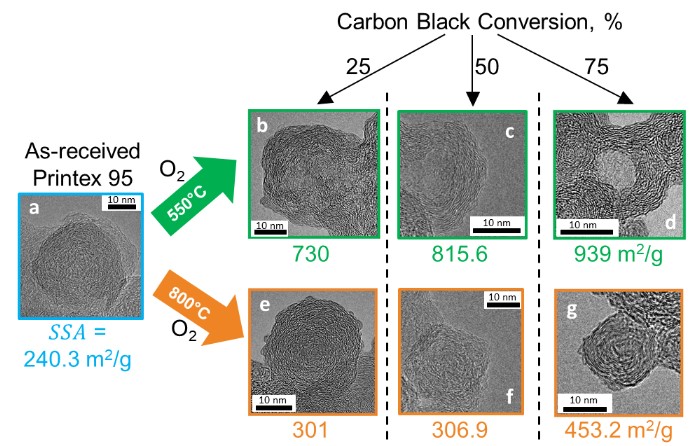Oxidation of carbonaceous materials (e.g. coal, biomass, soot and carbon black, CB) determines their emitted mass concentration (Kelesidis and Pratsinis, 2021a), production rate and performance in various applications (Kelesidis and Pratsinis, 2021b). Here, the structure of CB is investigated during its oxidation by O
2 at 550 and 800
oC by thermogravimetric analysis, microscopy, N
2 adsorption and X-ray diffraction (XRD). That way, the dynamics of its porosity and crystallinity during surface and internal oxidation are elucidated, for the first time to the best of our knowledge. At 800
oC, oxidation takes place largely on the CB surface. This increases the CB specific surface area,
SSA, from 240 to about 453 m
2/g (Fig. 1), closely following the classic shrinking particle model and hardly affects porosity and crystallinity of CB. At 550
oC, O
2 diffuses and reacts with the bulk of CB particles forming pores with radius smaller than 2 nm after 25 and 50 % conversion. Fractal analysis of these pores and XRD reveal that internal oxidation reduces the interlayer spacing of the constituent crystallites of CB. This compacts its pore network and increases the pore fractal dimension,
Dfp, from 2.43 up to about 2.7, in good agreement with the
Dfp measured during diesel soot oxidation. At higher conversions, the small pores fuse resulting in hollow particles with SSA = 939 m
2/g. These structures are similar to those obtained by low temperature oxidation of biodiesel and diesel soot, as well as to oxygen-treated CBs (e.g. Ketjenblack) used in Li-ion batteries. So, the low temperature oxidation dynamics of CB porosity and crystallinity quantified in detail here can assist the derivation of robust oxidation rates (Kelesidis and Pratsinis, 2019), as well as the design of highly porous carbonaceous nanomaterials for filters and battery electrodes.
References:
Kelesidis, G. A., and Pratsinis, S. E. 2019. Estimating the internal and surface oxidation of soot agglomerates. Combust. Flame 209:493-499, doi.org/10.1016/j.combustflame.2019.08.001.
Kelesidis, G. A., and Pratsinis, S. E. 2021. Determination of the volume fraction of soot accounting for its composition and morphology. Proc. Combust. Inst. 38:1189-1196, doi.org/10.1016/j.proci.2020.07.055.
Kelesidis, G. A., and Pratsinis, S. E. 2021. A perspective on gas-phase synthesis of nanomaterials: Process design, impact and outlook. Chem. Eng. J. 421:129884-1-7, doi.org/10.1016/j.cej.2021.129884.
Figure 1. Microscopy images and SSA of (a) as-received and (b-g) oxidized CB at 550 (b-d) and 800 oC (e-g) after 25 (b, e), 50 (c, f) and 75 % (d, g) conversion.


